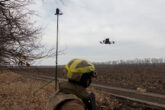July 30, 2014
The wrong stuff: The F-35 vs. what U.S. airpower really needs in the future
The fact that the F-35 Lightning II isn’t making an appearance at the Farnborough International Airshow is the latest in a never-ending string of disappointments that have marked the plane’s controversial history. From past challenges with tail hooks and tires to engine cracks and engine fires, life has never been easy for the F-35, which has even had to confront an embarrassing vulnerability to its namesake weather phenomenon.
Such setbacks might be acceptable — and expected — in a nascent experimental program, but the F-35 has already been in production for 8 years. Indeed, largely due to concurrent testing and production, an approach that Under Secretary of Defense for AT&L Frank Kendall memorably referred to as "acquisition malpractice" (and one that hopefully will not be replicated any time soon), DOD will spend $1.65 billion merely to bring early-production jets up to standard. Total program acquisition costs will reach $398.6 billion, with 55-year life-cycle costs surpassing the stratospheric $1 trillion mark, thus solidifying the F-35’s legacy as the most expensive weapons program in history.
Read the full post on Foreign Policy's Best Defense blog.
More from CNAS
-
Defense / Transatlantic Security
When Defense Becomes Destruction: Austria-Hungary’s Mistake and Ukraine’s RiskThis article was originally posted on War on the Rocks. The southeastern Polish city of Przemyśl, with its elegant 19th century Habsburg-era train station, remains one of the ...
By Franz-Stefan Gady
-
Defense / Transatlantic Security
Ukraine’s Catch-22 MomentThis article was originally published in the Financial Times. In Joseph Heller’s wartime classic, Catch-22, the protagonist Yossarian seeks out the US army surgeon Doc Daneeka...
By Franz-Stefan Gady
-
CNAS Insights | Budgetary Own Goals Undermine “Speed and Volume”
On November 7, Secretary of Defense Pete Hegseth laid out a plan to overhaul the Department of Defense’s (DOD’s) acquisition system. Placing an emphasis on delivering new capa...
By Philip Sheers, Carlton Haelig & Stacie Pettyjohn
-
Drones: Who Is Making the New Weapons of War?
From Ukraine and Russia to Gaza and Sudan, drones have become a key weapon of war. Which companies are making them, and profiting from this rapidly expanding but controversial...
By Stacie Pettyjohn




